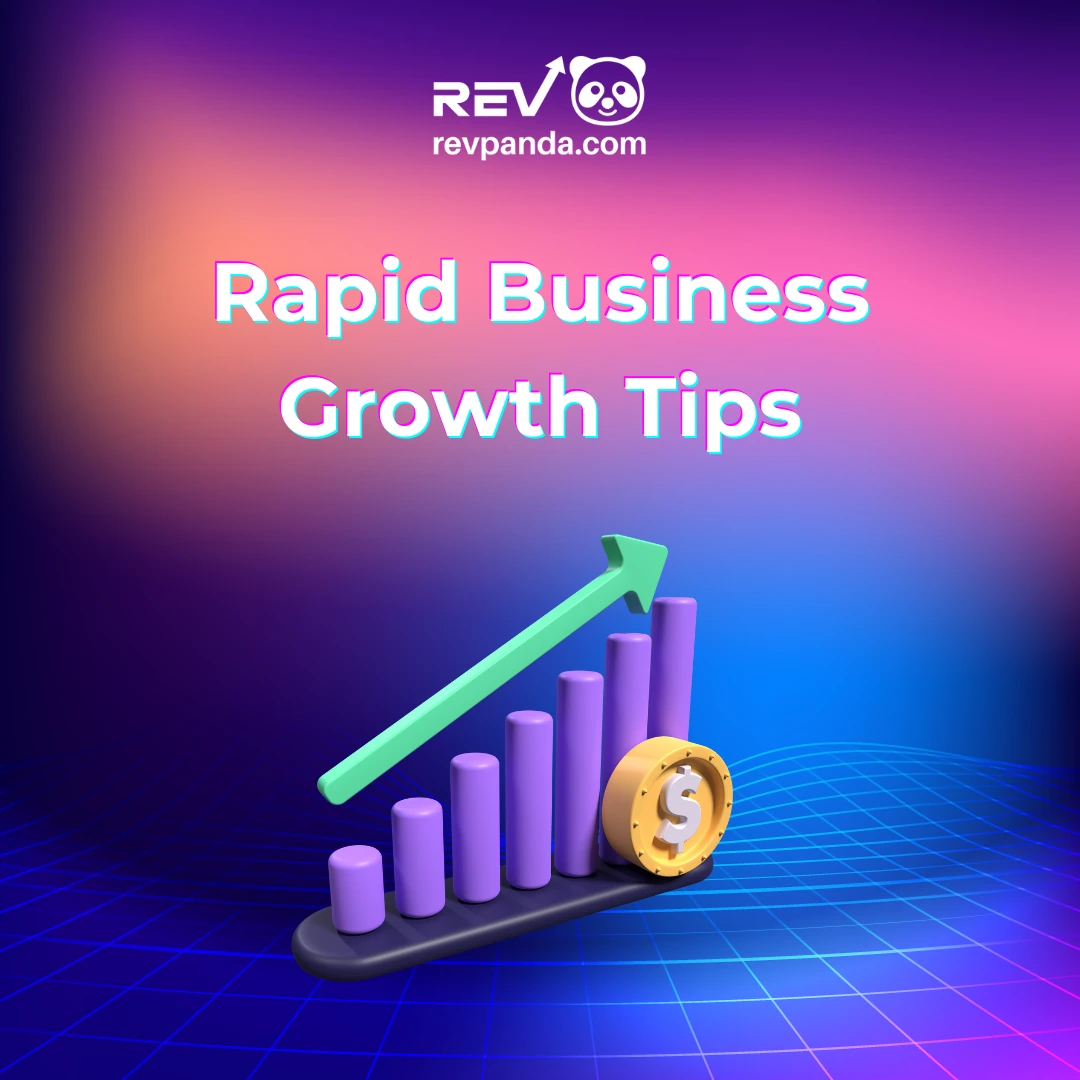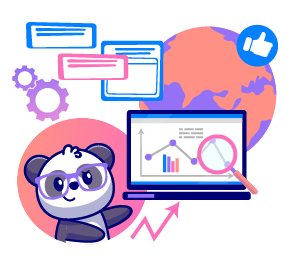
BLOG
Best Rapid Business Growth Tips and Strategies in 2025
Table of contents
Click on a title to jump to a section
What Is Business Growth?
In the context of business, growth signifies a company’s positive development and expansion over a defined period. This advancement is usually measured through key performance indicators (KPIs) such as revenue, market share, customer base, and brand awareness. From a steady rise in a company’s revenue to a strategic expansion into new markets, these growth milestones all contribute to the process of growing a business into a market leader. However, growth extends beyond mere size; it encompasses a company’s increasing influence within its industry and an enhanced capacity to deliver value to its target audience. Thus, business growth represents a strategic pursuit of long-term sustainability and the achievement of a dominant position within an industry.
Business Growth Strategies You Should Know
There are two primary avenues through which businesses grow: organic and inorganic growth. Both have their own unique benefits and limitations. Let’s consider how companies leverage them.
Organic growth: This refers to a sustainable approach that utilises a company’s internal resources and efforts to expand its market share and profitability. This may involve developing new products or services, improving operational efficiency to reduce costs, or enhancing customer service to cultivate loyalty. By strengthening the core competencies of its business model and fostering a culture of innovation, a company can achieve growth over time.
Inorganic growth: This one, on the other hand, involves using external factors to achieve a more rapid expansion. A common way to do this is through mergers and acquisitions (M&A), where a company combines with another existing entity. Also, strategic partnerships and joint ventures can unlock new opportunities, allowing many businesses to access new markets, new technologies, or resources that may not have been favourable to develop internally due to the money required.
Product Development
Product development involves thinking ahead and creating innovative products or services that cater to evolving customer needs and market demands. By expanding your product portfolio to include novel products or adding new features to existing offerings, you can attract new customers, retain existing ones, and generate additional revenue streams through sales.
Market Development
This business growth strategy involves identifying and entering new markets for your existing products or services. Growth-driven businesses target untapped customer segments and continually expand into new geographical territories, e.g., opening new stores. This can significantly increase your customer count and brand reach.
Market Penetration
Market penetration focuses on increasing your market share within your existing market. Common strategies include employing effective marketing campaigns, optimising pricing strategies, or enhancing customer service. The goal is to win over potential customers from other businesses and solidify your position within the established market space.
Diversification
Diversification involves introducing new products or services to new markets or industries. With related diversification, you expand into similar markets, while unrelated diversification involves entering entirely different markets or industries. With this strategy, your growing business quickly taps into fresh revenue streams, and it mitigates risk by reducing dependence on a single market.
Horizontal Integration
Horizontal integration refers to merging with or acquiring a competitor within the same industry or market. Integration-focused growth strategies strengthen your market position by eliminating competition and increasing your consumer base. Additionally, you can potentially achieve economies of scale through combined resources within a great network.
Vertical Integration
Vertical integration means gaining control of different stages (upstream or downstream) within your supply chain. This may involve acquiring the suppliers of your raw materials or the final product distributors. Such a strategy can enhance the efficiency of your production line, reduce reliance on external partners, and potentially secure a steady flow of resources.
Strategic Alliances and Partnerships
This rapid business growth strategy involves collaborating with complementary businesses to unlock new opportunities. Partnerships can leverage partner strengths, expand market reach, and share development costs. Such a rapid expansion strategy accelerates growth for the two companies without full-scale mergers.
Revenue Growth
This strategy focuses specifically on increasing the total income generated by your established revenue sources. It can involve any tactic that raises your top line, such as upselling existing customers, attracting new high-value clients, or introducing premium product tiers. You can achieve sustainable revenue growth by optimising your sales funnel and maximising the value proposition.
Customer Base Growth
Customer base growth prioritises expanding the number of customers your business serves. Common initiatives include targeted marketing campaigns, developing referral programs, or lowering prices to attract new customer segments. To cultivate a thriving and ever-expanding consumer base, you need to foster customer retention and satisfaction.
Brand Awareness and Reputation Growth
This business strategy relies on increasing public recognition and positive perception of your brand. Implementing targeted marketing campaigns, engaging with existing customers on social media platforms, and prioritising exceptional customer service can all contribute to building brand awareness and reputation. A well-recognized and respected brand attracts more customers and promotes long-term loyalty.
Top 9 Rapid Growth Tips for Businesses
Growing a business can be an exciting yet challenging endeavour for many people. While organic strategies foster long-term sustainability, achieving significant progress within a short timeframe often necessitates a tactical blend of internal efforts and external growth opportunities. We have curated a selection of nine powerful growth tips that high-performing brands use to propel themselves into becoming business leaders. By implementing and tailoring these tactics to your specific industry and goals, you will ensure that your company grows.

Define a Clear Vision and Plan a Growth Strategy
Before embarking on your growth journey, a well-defined vision should serve as your guiding light. This vision must encapsulate your aspirations for the company’s future, outlining the impact you aim to make and the ultimate destination you desire to reach. A comprehensive growth strategy should rely on a firmly established business plan. This roadmap must detail the specific actions you will take to achieve your vision. A popular framework for this strategy is SMART—Specific, Measurable, Achievable, Relevant, and Time-bound goals ensure that your ambitious vision is translated into actionable steps for rapid progress.

Invest in Marketing and Sales
In today’s competitive marketplace, a robust marketing and sales engine is the lifeblood of business growth. Your marketing strategy should leverage a multi-channel approach to reach your target audience. You need a strong online presence, a user-friendly website, and engaging social media campaigns. Informative blog posts, targeted email marketing, and other content marketing endeavours can further establish your brand as a thought leader and nurture leads through the sales funnel. Investing in expert SEO services can significantly improve your website’s ranking in search engine results, driving organic traffic necessary for increasing sales and conversions.

Prioritise Customer Experience and Value
Did you know that over 50% of customers will switch to a competitor after one bad experience? In the age of the empowered consumer, an exceptional customer experience is no longer a nicety but a necessity for rapid growth. Focus on creating a seamless and positive experience at every touchpoint, from initial brand interaction to post-purchase support. This may involve automating customer communication through chatbots or email sequences for faster response times. By streamlining processes and addressing concerns efficiently, you cultivate customer satisfaction and loyalty. Furthermore, prioritise exceeding customer expectations by consistently listening to feedback and delivering value. Offer high-quality products or services that solve their problems and enhance their lives.

Build Strategic Partnerships
Collaboration is a powerful driver of rapid growth. And forging strategic partnerships with complementary businesses can unlock a wealth of growth opportunities. Partnerships allow you to leverage each other’s strengths, expanding your market reach and expertise without extensive capital investment. For instance, you can collaborate with a company that possesses a strong distribution network while offering a unique product. This strategic alliance can propel both businesses forward by reaching new customer segments and maximising combined resources. However, choose your partners wisely. Seek collaboration with businesses that share your values and complement your brand.

Invest in Training Employees
Your employees are the backbone of your organization; their skillset directly impacts your capacity for growth. Investing in employee training and development programs equips your workforce with the expertise and tools necessary to excel in their roles. Training can encompass industry-specific skills, leadership development, or customer service excellence programs. If you want your employees to adapt to evolving market trends and contribute more effectively to your growth objectives, foster a culture of continuous learning. A skilled and engaged workforce translates to increased productivity, improved customer satisfaction, and ultimately, a significant competitive advantage.

Attract and Hire Top Talents
A high-performing team propels rapid business growth by outperforming competitors. To achieve this, prioritise talent when hiring more employees within your industry. This begins with crafting compelling job descriptions that showcase your company’s culture and growth opportunities. You can leverage professional networking platforms like LinkedIn to connect with skilled candidates. Implement a robust interview process that assesses not just technical skills but also cultural fit and potential for future development. Finally, offering competitive compensation packages and fostering a positive work environment can help you attract and retain the best talent. This ensures your business plans get the human capital necessary to scale and achieve ambitious goals.

Stay Agile and Adaptable
The ability to adapt to change is crucial for managing rapid business growth because the business landscape is a dynamic ecosystem. Thus, embrace a culture of agility, encouraging creativity and innovation within your team. A good way to do this is by implementing recession-proof strategies that allow you to quickly gather market feedback, iterate on product offerings, and adjust marketing strategies. Staying agile ensures you seize new opportunities as they arise and navigate the unforeseen challenges of unexpected growth effectively. The most successful businesses are those that can learn, adapt, and evolve at pace with the dynamic demands of the market.. Consumer expectations and demands change with time. Thus, adaptability doesn’t just facilitate growth; it is necessary for the survival of your business.

Foster a Culture of Innovation
Rapid growth thrives on a constant stream of fresh ideas. Cultivate a culture of innovation within your organisation to encourage your team’s creative potential. Holding brainstorming sessions and celebrating out-of-the-box thinking can empower your employees to experiment with new solutions. Provide resources for ongoing learning and professional development in relevant fields. By fostering an environment that embraces new ideas and calculated risks, you position your company to be at the centre of innovative products, propelling you ahead of the competition. Remember, a culture of innovation is not just about generating ideas; it’s about fostering an environment where those ideas can be nurtured, tested, and ultimately transformed into the driving force behind your company’s success.

Optimise Operations for Maximum Efficiency
To achieve sustainable growth, you must implement streamlined and efficient processes as the foundation of your business. Identify and eliminate bottlenecks within your processes, whether in production, logistics, or customer service. Additionally, embrace automation technologies where applicable to reduce manual tasks and human error. It’s also crucial to implement continuous process improvement initiatives. This ensures that you regularly analyse performance metrics to identify areas for improvement. By optimising your operations, you reduce wasted resources and costs. Thus, your business functions at peak efficiency, allowing you to scale effectively and meet market demands.
Organic Business Growth vs Inorganic Business Growth
Organic growth ensures a sustainable and long-term approach, while inorganic growth offers a faster path to business expansion. But which strategy is right for your business? Let’s explore the key differences and weigh the pros and cons of each approach.
This is a gradual process that relies on internal efforts like product development, marketing campaigns, and operational improvements.
Inorganic growth, through acquisitions or mergers, provides immediate access to new markets, customer bases, and resources.
There’s less risk of unforeseen complications or integration challenges.
Inorganic growth carries inherent risks such as integration challenges, cultural clashes, and potential difficulties managing newly acquired assets.
You retain complete control over your company’s direction, brand identity, and culture during organic growth.
Merging with another entity requires some level of shared control and decision-making.
There’s no need to integrate different company cultures or systems since you’re building upon your existing foundation.
Integrating different company cultures, systems, and workforces can be complex and time-consuming.
Organic growth depends on your ability to generate internal resources to fund your initiatives.
Depending on the inorganic strategy, significant financial investment may not be needed for partnerships.
With gradual expansion, you enter new markets slowly. But this may take considerable time or resources.
Acquisitions or partnerships offer an immediate foothold in new markets, bypassing the time it takes for organic expansion.
Making Business Growth Easy with a Clear Vision and Goals
Navigating the complexities of scaling your business requires careful planning and strategic execution. By implementing the powerful growth tips and strategies we outlined in this guide, you will equip yourself with the tools necessary to make your business grow. Remember, a clear vision should guide your decisions. And with a well-defined growth strategy, you can transform that vision into actionable steps for achieving remarkable success. Luckily, you can get professional support. With a proven track record of marketing excellence, Revpanda can help you through customer-centric strategies that drive results. The path to rapid business growth awaits. Take the first step by reaching out to us.
Rapid Business Growth FAQ

